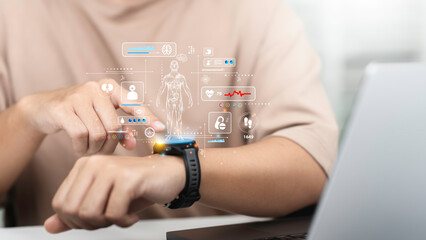
Wearables FeedWorldTech technology has transformed from a niche gadget into a mainstream innovation that touches healthcare, fitness, lifestyle, and enterprise solutions. The term wearables FeedWorldTech reflects not only the devices themselves but also the vast ecosystem of innovation, connectivity, and data-driven functionality shaping this sector. These devices are more than accessories; they are becoming integral parts of modern living, enhancing human performance, safety, and convenience.
The Evolution of Wearable Technology
The story of wearables began with simple fitness trackers and digital watches. Over time, their capabilities have expanded into areas like health diagnostics, augmented reality (AR), smart clothing, and even implantable devices. FeedWorldTech’s insights into this industry highlight how rapid innovation continues to redefine boundaries. Today’s devices track everything from heart rates to oxygen levels, while future models may seamlessly integrate with artificial intelligence (AI) and the Internet of Things (IoT) for predictive analytics.
Categories of Modern Wearables
1. Smartwatches and Fitness Trackers
Smartwatches and trackers remain the most popular forms of wearable devices. They offer real-time monitoring of physical activities, health stats, and communication features, making them indispensable tools for fitness enthusiasts and professionals.
2. Smart Clothing and Fabrics
Smart fabrics represent the convergence of fashion and technology. From shirts that monitor muscle activity to shoes that analyze posture, smart clothing enhances performance in sports and provides medical-grade monitoring for patients.
3. Augmented and Virtual Reality Devices
Head-mounted displays, AR glasses, and VR headsets are expanding wearables into gaming, education, healthcare training, and remote work. Their applications are vital for industries requiring simulation and immersive experiences.
4. Implantable and Medical Wearables
Implantable devices, such as pacemakers with wireless monitoring, illustrate how wearables are revolutionizing healthcare. Non-invasive biosensors are also emerging as critical tools in remote patient care and chronic disease management.
 Applications of Wearables in Key Sectors
Applications of Wearables in Key Sectors
Healthcare and Wellness
Wearables have revolutionized healthcare by enabling remote patient monitoring, preventive diagnostics, and personalized treatments. Hospitals use them to monitor vital signs continuously, reducing readmission rates and improving patient care.
Sports and Fitness
Athletes and trainers rely heavily on wearables for insights into performance, fatigue levels, and recovery time. Devices tailored for professional sports integrate biomechanics to optimize training outcomes.
Workplace and Enterprise Use
In industries like construction, mining, and logistics, wearables improve worker safety and productivity. Smart helmets and AR glasses guide workers, reduce accidents, and enhance efficiency.
Education and Training
AR and VR wearables create immersive classrooms, enabling students to interact with virtual objects and scenarios, transforming learning into an engaging, hands-on experience.
Emerging Trends in Wearable Technology
-
AI-Powered Analytics – Devices will soon analyze collected data in real-time, providing instant health or lifestyle recommendations.
-
Energy Harvesting – Future wearables may generate their power using solar or kinetic energy, reducing dependence on charging.
-
Edge Computing Integration – Processing data closer to the device enhances speed and reduces latency in critical applications.
-
Personalized Experiences – From healthcare alerts to tailored workout plans, wearables adapt to individual user needs.
-
Integration with Smart Ecosystems – Wearables are becoming central hubs in the IoT, connecting seamlessly with smart homes, cars, and workplace systems.
Challenges Facing Wearables Development
-
Data Privacy Concerns: Wearables collect sensitive health and personal data, raising security challenges.
-
Battery Limitations: While innovations are underway, battery life remains a significant hurdle.
-
Adoption Costs: Advanced wearables can be costly, slowing adoption rates in emerging markets.
-
Standardization Issues: Different manufacturers often use unique ecosystems, creating compatibility concerns.

The Future Outlook of Wearables FeedWorldTech
As industries increasingly adopt smart technology, wearables FeedWorldTech stands at the center of innovation. Whether in healthcare, enterprise, or consumer lifestyle, wearables will likely become as essential as smartphones. With AI, IoT, and sustainable energy powering their evolution, these devices are expected to reshape not only how we live but also how we connect to the digital ecosystem.
FAQs
1. What is the meaning of Wearables FeedWorldTech?
It refers to wearable technology advancements and insights covered under the tech ecosystem of FeedWorldTech, focusing on global innovations.
2. How are wearables transforming healthcare?
They enable remote monitoring, personalized treatments, and continuous health tracking, reducing hospital visits and improving patient outcomes.
3. What are some examples of wearable devices?
Examples include smartwatches, fitness trackers, smart clothing, AR glasses, VR headsets, and medical-grade biosensors.
4. What challenges do wearables face today?
Major challenges include short battery life, high costs, privacy concerns, and the lack of universal standards across devices.
5. What does the future hold for wearables?
The future points to more AI-driven, energy-efficient, and seamlessly integrated devices that will expand across industries and daily life.
Read Also: Why 10.235.10205 Matters in Today’s Digital World





